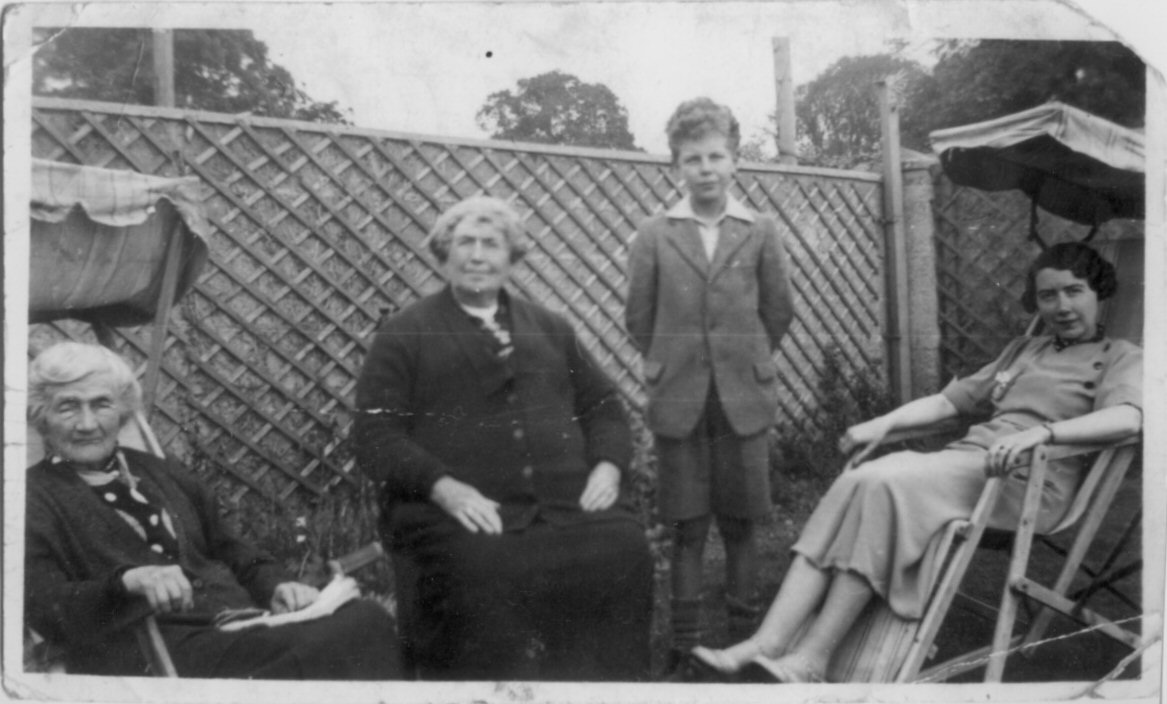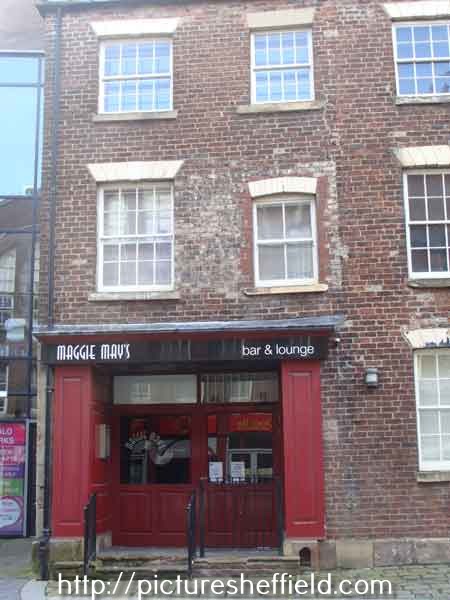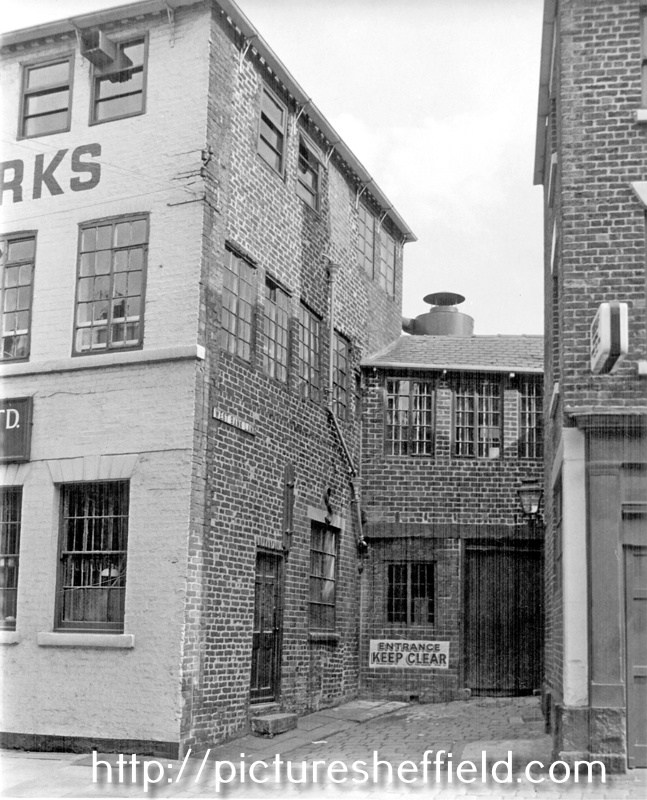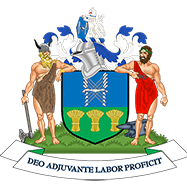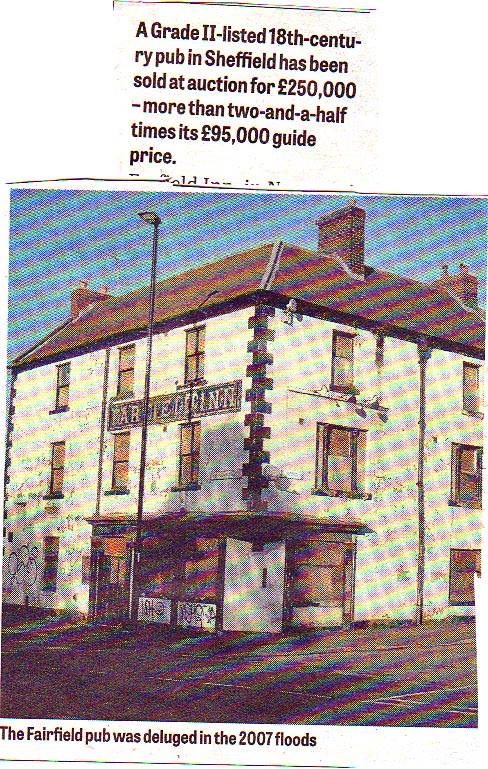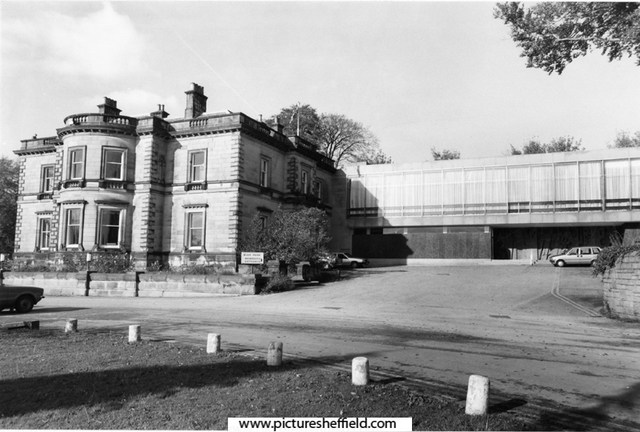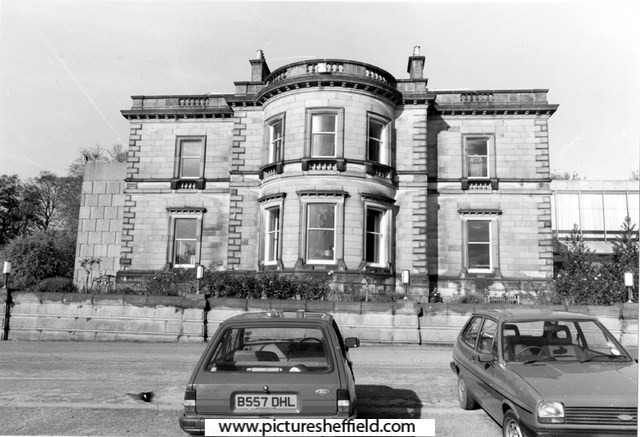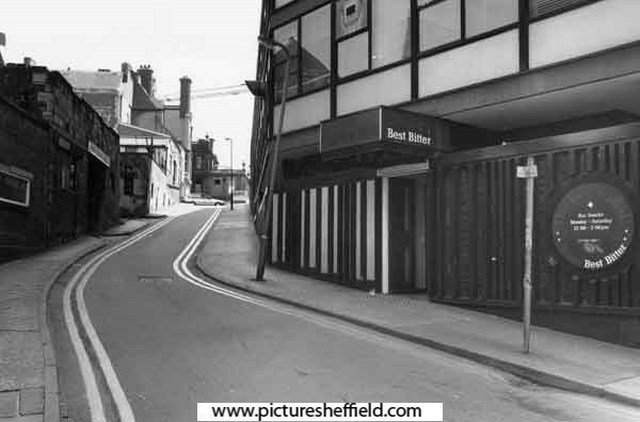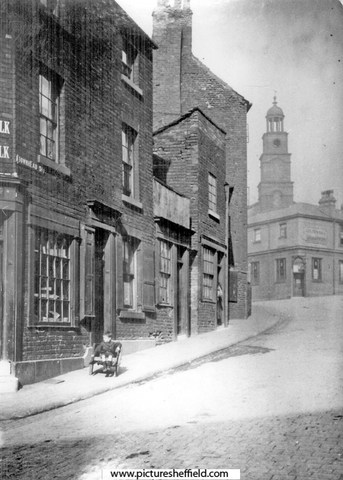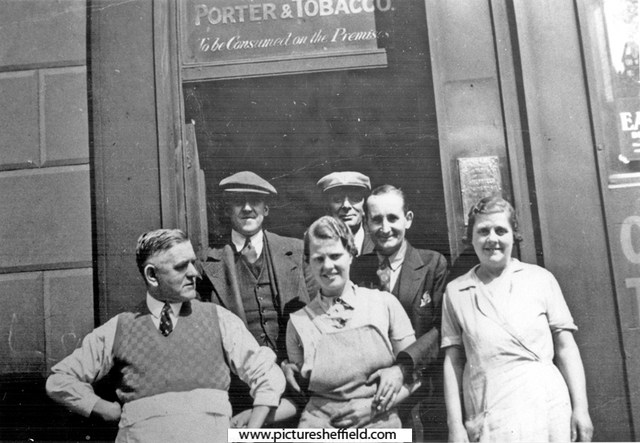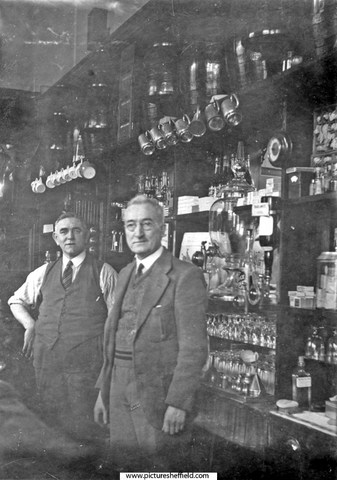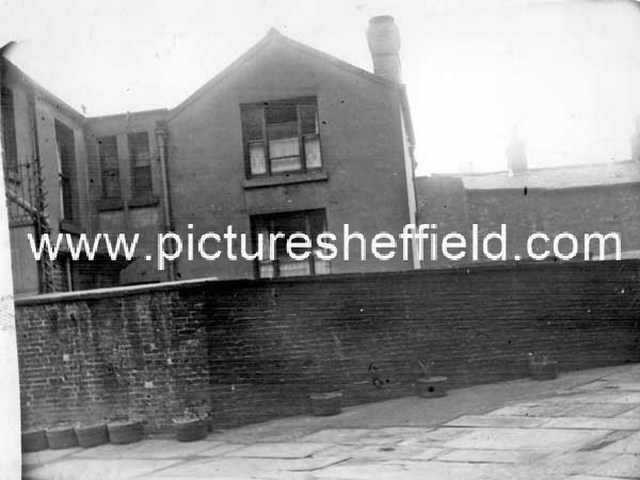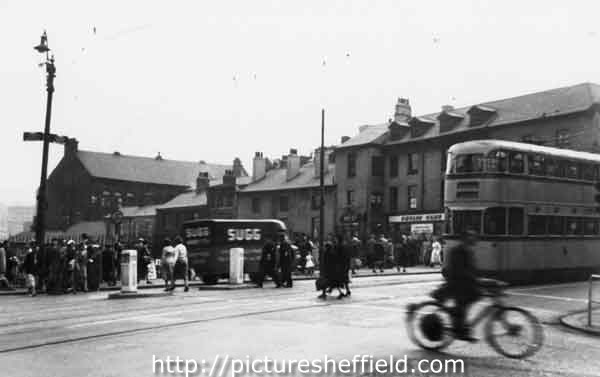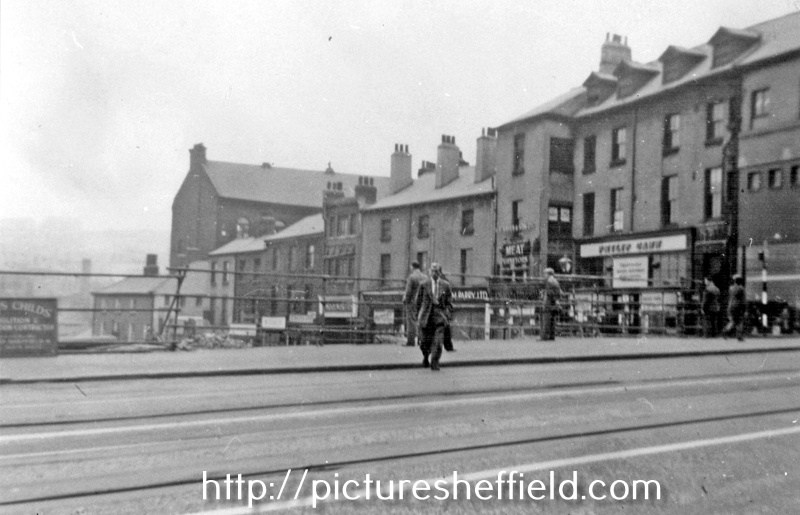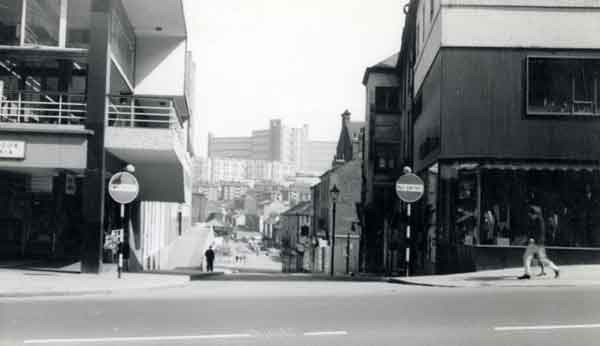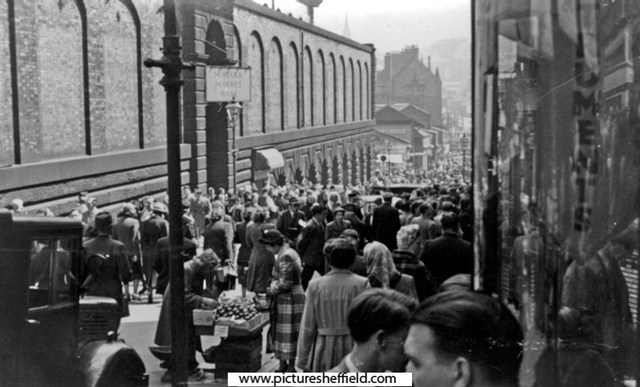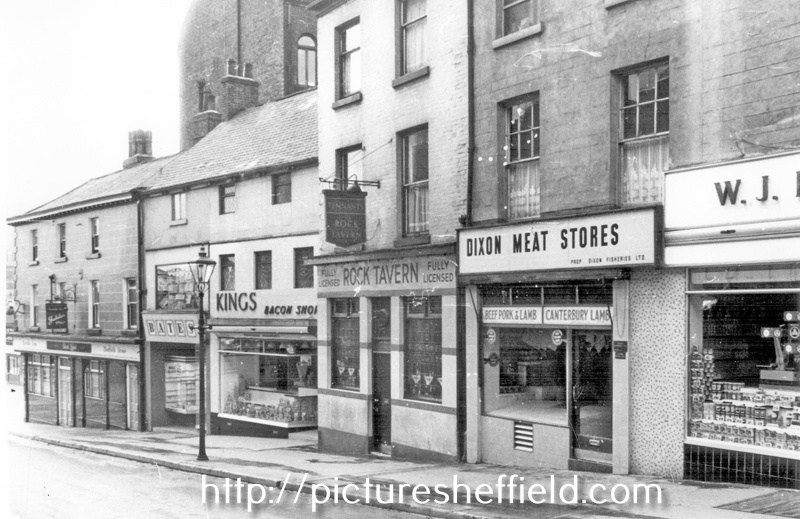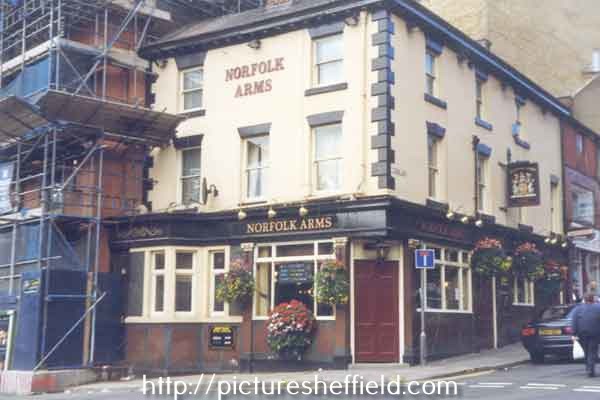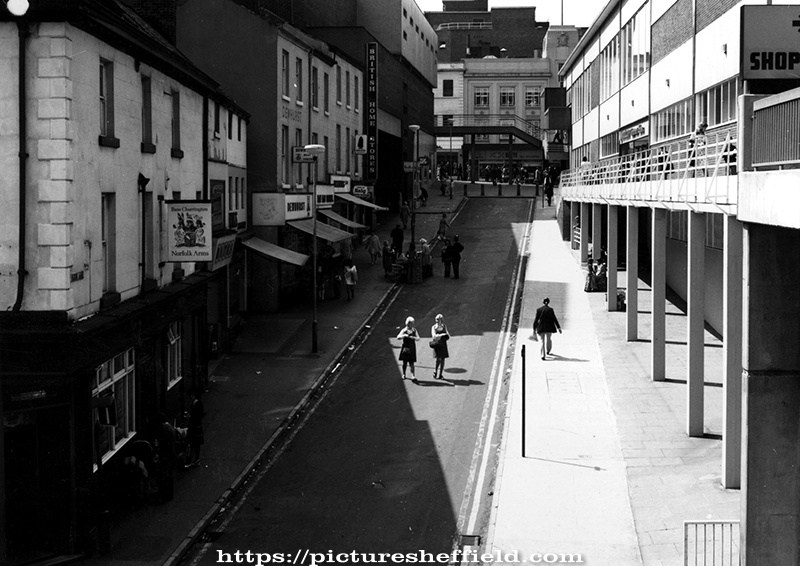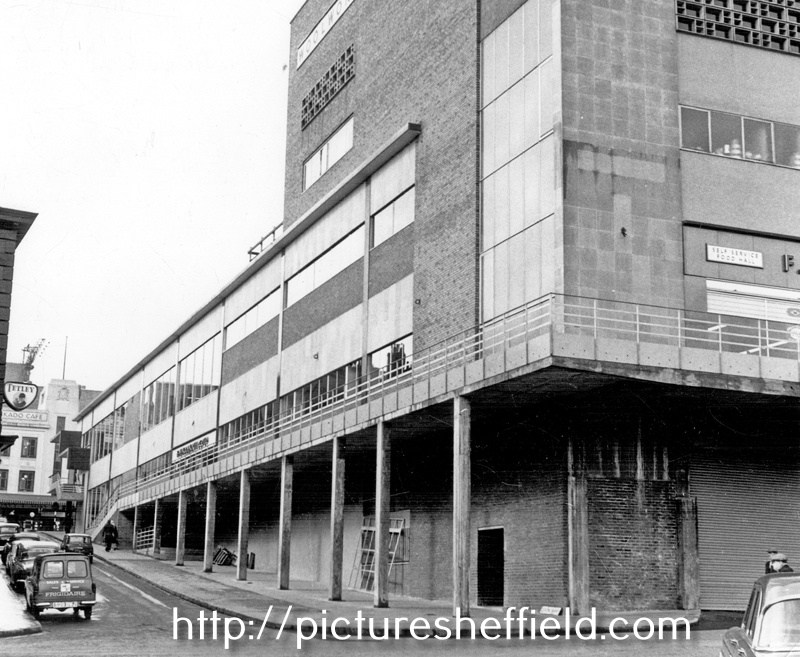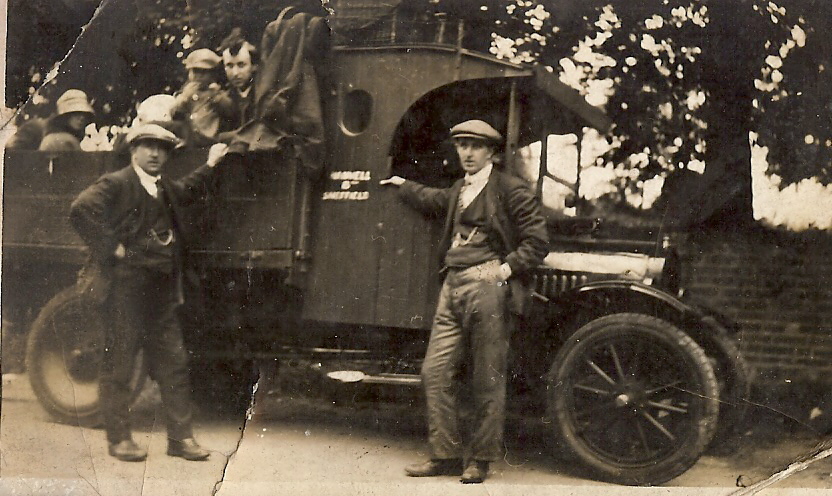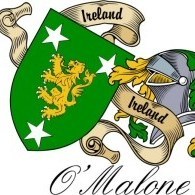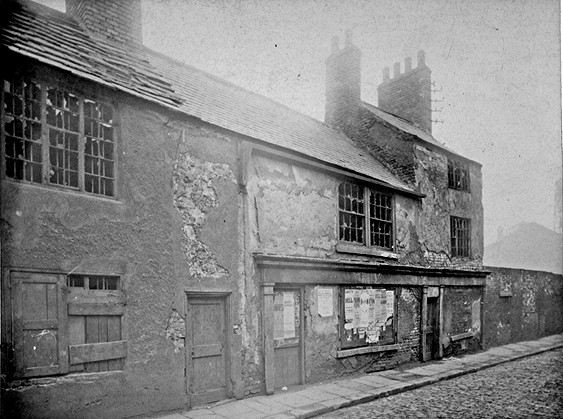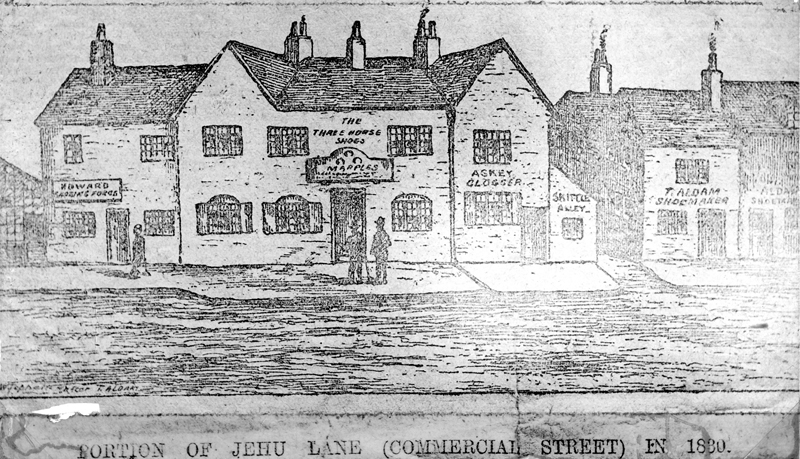Search the Community
Showing results for 'coal pit lane'.
-
Hi I’m doing some research into my family history and wondered if anyone has any information on the “George and Dragon” that used to stand at 93 Broad Lane. I believe it operated as a pub between 1825 and 1958. The building was later demolished and the site where it stood now seems to be a car-park. My family connection is that in about 1903 it was taken over by my Great-Great-Aunt Norah and her husband Thomas Crosby (they had previously run the ‘Union’ around the corner on Scotland Street) Thomas died in 1906 and Norah was remarried to a man named John Gaffey, John died around 1918 so Norah then ran the pub with her daughter Eileen. Norah died in 1942, at which point Eileen ran it herself until it closed in 1958. Norah was from Glenamaddy in Co. Galway and “Gaffey’s” as it was generally known was always considered to be an ‘Irish pub' and I believe there was a back room where they had Irish music and dancing My dad would be taken there as a young boy by his father and remembers Norah as a very ‘large’ and somewhat intimidating lady who’s fingers were always adorned with several big rings. I’ve attached a photo of Norah and Eileen, Norah is second from left and her daughter Eileen is on the right. If anyone has any info, memories or photographs of ‘Gaffey’s (or indeed the Union on Scotland St.) it would be much appreciated. Mike O’Farrell
-
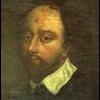
What does "main" mean in a colliery name ?
History dude replied to JS2021's topic in Sheffield History Chat
Coal is found at different levels in the ground. And in different seams. The main seam would be the biggest deposit of coal in a seam. The seams were given names like Parkgate and Silkstone etc. -
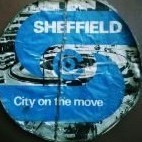
What does "main" mean in a colliery name ?
Busmansholiday replied to JS2021's topic in Sheffield History Chat
Yes, I believe it's to do with the fact that the pits are all removing coal from the same seam (layer) of coal. -

What does "main" mean in a colliery name ?
winco1960 replied to JS2021's topic in Sheffield History Chat
My wife used to work for the coal board at Queens House in Sheffield dealing with accident claims during the eighties. Until the miners strike there were 56 collieries in Yorkshire. Only 6 had the word "Main" in the title. Barnsley, Hickleton, Houghton, Manvers, Markham and Yorkshire ( Doncaster ). From her recollections she believes these sites had multiple shafts and were linked. For instance Manvers was linked underground with Wath, Barnburgh and Kilnhurst but all the coal mined in these pits were all raised at Manvers. -

Booth & Co., Park Iron Works, Brightside Forge & Royds Mill.
Ponytail posted a topic in Made In Sheffield
History of Booth & Co. https://www.gracesguide.co.uk/Booth_and_Co#General A Map of the Lands and Works in the north park of Sheffield Park. 1788. https://www.picturesheffield.com/frontend.php?keywords=Ref_No_increment;EQUALS;y09966&pos=2&action=zoom&id=65481 Amongst others named: John Booth & Co. 19. Little Bank with House. 21.The Meadow. 22 & 20. Furnace Foundry and other Works. Road to the from Attercliffe Bridge, Dam and other Watercourses, Banks above the Dam and by the River. (Property near to Royds Mill Weir) Also Marked: River Sheaf; Hospital Grounds; Land held by Wm. Shipley; Road to the Farms in the Park, Cricket Inn Road; Castle Orchards; wear (weir); River Dun (Don); Simon Wheel Upper Dam; Simon Wheel Lower Dam; Simon Wheel; Walk Mill Wear (Weir); Royds Mill Wear (Weir); Furnace Dams; Dewee Close; Other Tenants: Thomas Taylor; Isaac Mower; Robert Rawson at Castle Orchards; Thomas Rodgers; Benjamin Blonk & Co. at Simon Wheel; John Woollas; John Froggatt; Benjamin Taylor; Samuel Revil; Hannah Hodgkinson; William Shipley; James Furniss; William Lord; R. Magnall and Ric'd Falkner; John Barber; James Kaye; John Steer; William Smith; William Kent & John Jowel. (Top of left of Map think it says) "Pencil? Numbers? Harrison Survey 1639. Also (parts listed) Surveyed W Fairbank 1789. A Plan of the Forges Tenements and works Brightside held of the Duke of Norfolk by John Booth and Co, drawn 1790, updated c.1810. (dated 2nd September 1811) https://www.picturesheffield.com/frontend.php?keywords=Ref_No_increment;EQUALS;arc01852&pos=1&action=zoom&id=18564 "The Fall from the top of Brightside Forge Wear (Weir) to the top of Brightside Paper Mill Wear to the middle of the wear at (a) is 8ft 7 1/2. From (d) to the south end of the wear at (b) is 8ft 5 1/2." "Held by the first long lease along with the Goights and Dam marked *. No. 3 New Forge and Rolling Mill with the Ground. No. 4 Dwelling House and Garden. No. 5 Close or Croft. No. 6 Forge and other buildings Dam Gardens & Lane leading to the Forge." Coloured Green (gives measurements) "Held by the second long lease Coloured Yellow No. 2 Two Houses with Gardens and other Ground." "Held by Common Lease No.1 A Close called The Holme. No. 7 The Island." (gives measurements) "* From the Compting House corner to the Company's Hedge next Lucy Southerons is Four Feet. August 5th 1804." Marked: River Dun (Don); Brightside Forge Wear (Weir); Forge & etc (Brightside Forge); Garden; Charcoal Yard; Road to Sheffield; Brightside Green; Road to Tinsley and Rotherham; New Forge & Brightside Paper Mill Wear (Weir). Also named: Earl Fitzwilliam's Land; John Whetham Esq.; Duke of Norfolk and late John Hartops. A Plan of the Houses and Ground near Brightside demised to J. Booth and Co. 1789. (Between Weedon Street and the River Don.) https://www.picturesheffield.com/frontend.php?keywords=Ref_No_increment;EQUALS;arc02690&pos=2&action=zoom&id=91532 Marked: Lane from Carbrook to Brightside & The Dun (River Don). Other Tenants: William Binks, tenant; Close held by the Widow of John Hartop. House, Garden, etc proposed to be taken of the Duke of Norfolk for the term of 99 years by John Booth and Co. 1796. (Between modern Effingham Road and the Park Furnace Dam.) https://www.picturesheffield.com/frontend.php?keywords=Ref_No_increment;EQUALS;arc03392&pos=3&action=zoom&id=98631 Also marked: Furnace Dam & Road to the works of J. Booth & Co. Iron Works of William Booth & Co, https://www.picturesheffield.com/frontend.php?keywords=Ref_No_increment;EQUALS;arc03547&pos=1&action=zoom&id=98880 Heald (Held) by a Common Lease: Upper Meadow; Lower Meadow; Little Bank; Above the Dam including the road and road by the River; upper part of H. Hodgkinsons Close. Heald by the first long lease: Old Dam with the goight leading to it from the River. Heald by second long lease: New Reservoir Banks & Watercourses round it. Furnace and other Works & Ground about them. House & Garden. Booth & Co. Park Foundry: (Copy) Minutes of meeting of the partners (Sayle, Shore, Binks, Hartop and Booth). 6th Jan 1825. https://discovery.nationalarchives.gov.uk/details/r/39bd2d25-afae-4ae7-9af9-8a1f07e8159d -

Unidentified Public Houses and Refreshment Rooms
Archaeo replied to Ponytail's topic in Sheffield History Chat
Newspapers name a few beerhouses on Hawley Lane. (Omitting references to the Reindeer, as we know that is not our unidentified photo). Patrick Whitton, beer seller, Hawley Lane. Mention in: Sheffield Independent Friday 21 April 1876 (re. fines for short pints) William Hannay, beer seller, Hawley Lane. Mention in: Sheffield Independent Friday 21 April 1876 (re. fines for short pints) Unnamed Beerhouse, Hawley Lane. Mention in: Sheffield Daily Telegraph Friday 29 January 1875 (to let, apply Spring Lane Brewery) Cork and Bottle, Hawley Lane. Mentions in: Sheffield Daily Telegraph Friday 18 March 1881 (referenced in report of assault) Sheffield Daily Telegraph Friday 14 November 1879 (reference in report of someone stealing soldiers’ shirts) Eagle Tavern, 3 Hawley Lane, Silver Street Head. Mentions in: Sheffield Daily Telegraph 13 January 1877 (to let) Sheffield Daily Telegraph Thursday 26 February 1880 (use as committee room) Sheffield Daily Telegraph Friday 30 December 1881 (advert for servant) Sheffield Daily Telegraph Saturday 22 October 1881 (reference in report of abuse of a girl and assault of Henry Bockling, landlord) Sheffield Daily Telegraph Monday October 17 1881 (reference in report of soldier being robbed); Sheffield Daily Telegraph Wednesday 28 June 1882 (re. Henry Bockling, landlord, fined for knowingly having prostitutes on premises); Sheffield Daily Telegraph Monday 14 August 1882 (re. advert for pianist) Sheffield Daily Telegraph December 15 1883 (re. to let, apply Scotland Street Brewery) -
Maggie May's, bar and restaurant, Trippet Lane. 2017. a03748 Photographer: Andrew Milroy Formerly No. 27, Brown Cow? Maggie May's, 23-27, Trippet Lane. https://publocation.uk/pubs/south-yorkshire/sheffield/maggie-mays It would be good to know what was on the sign at No. 27 (right) Is it Brown Cow? West Bank Lane from Trippet Lane, No. 23 Walter Trickett and Co Ltd., spoon and fork makers, Anglo Works, left. July 1969. s20375
-
No. 27 Trippet Lane and the junction of West Bank Lane. https://www.picturesheffield.com/frontend.php?keywords=Ref_No_increment;EQUALS;v02668&pos=19&action=zoom&id=44370 Former premises of Walter Trickett and Co Ltd., Anglo Works (extreme left) and No. 27 Trippet Lane with West Bank Lane between. 2001. https://www.picturesheffield.com/frontend.php?keywords=Ref_No_increment;EQUALS;v03115&pos=2&action=zoom&id=44812 Former premises of the (Old) Brown Cow?
-
-
As most of my family appear to have lived around what is now Upperthorpe, Netherthorpe, through to the town centre along Solly Street and Townhead Street, I was hoping to find Coalpit Lane near there as I have a branch of my family living there. I know roads ‘disappear’ over time and wondered which map I should look at to see if there ever existed Coalpit Lane in this area. Any suggestions would be greatly appreciated. Thanks
-
Tapton Hall, Shore Lane showing extension built 1968 by Hadfield, Cawkwell and Davidson. October 1988. s29369 s29367
-
Hi Can anyone point me in the right direction to obtain a map of Sylvester Lane in 1880s? Ideally with the court/house numbers. Thanks in advance A
-
Plan of Land near Portobello agreed to be leased by Benjamin Withers to Samuel Sharman and others. 1835. https://www.picturesheffield.com/frontend.php?keywords=Ref_No_increment;EQUALS;arc03848&pos=38&action=zoom&id=99542 Marked: Glossop Road; Withers Street; Withers Lane; Cavendish Street.
-
Part of Robert Brightmore's late premises at the top of Church Lane bought by Wild and Pass.1820, 1824. https://www.picturesheffield.com/frontend.php?keywords=Ref_No_increment;EQUALS;arc04043&pos=4&action=zoom&id=90822 Also, other property of Wild and Pass and Ann Hancock in Orchard Lane and Sands Paver [Sands Paviours]. The plan has been cut and pasted to an outline of the adjacent properties and the first suggested line of Bow Street drawn across. Refers to John Sheldon, Orchard Lane, Church Street, William Pass, James Wild, Independent Methodists Society, Ann Hancock, John Milward, Bow Street. Firth College, Leopold Street / Bow Street, 1891 https://www.picturesheffield.com/frontend.php?keywords=Ref_No_increment;EQUALS;arc07488&pos=400&action=zoom&id=106877 Shows Sands Paviours.
-

The Golden Ball in Sheffield
Ponytail replied to Sheffield History's topic in Sheffield Pubs and WMC's
The Golden Ball public house, No. 69 Campo Lane from Vicar Lane. 29th June 1986.s30843 The Golden Ball public house, No.69 Campo Lane. https://www.picturesheffield.com/frontend.php?keywords=Ref_No_increment;EQUALS;t09557&pos=2&action=zoom&id=47272 -

The Golden Ball in Sheffield
Ponytail replied to Sheffield History's topic in Sheffield Pubs and WMC's
Townhead Street looking towards Campo Lane and the Golden Ball public house, gable belongs to the Burns public house, St. James Church Spire in background. 1898.y00595 Group including landlord Tommy Ward outside the Golden Ball public house, Townhead Street/Campo Lane. s09419 Information with the photograph. "Tommy Ward 'Senior' is on the left." Interior of The Golden Ball. 1937.s07031 Information with the photograph. "Mr. T. W. Brookes, on the right, was the landlord and Mr Tom Ward the barman.The Golden Ball was popular with actors from the Playhouse." St. James' Churchyard and rear Golden Ball public house, No. 69 Campo Lane and No. 10 Townhead Street. u00720 Ordnance Survey Map 1890, sheet no. Yorkshire No. 294.8.16. https://www.picturesheffield.com/frontend.php?keywords=Ref_No_increment;EQUALS;q00082&pos=7&action=zoom&id=152826 -
S. Newbould’s premises on Little Sheffield Moor, and John Taylor’s house, 1787. https://www.picturesheffield.com/frontend.php?keywords=Ref_No_increment;EQUALS;arc03771&pos=28&action=zoom&id=99407 Land purchased of the Duke of Norfolk by Samuel Newbould and Thomas Holy at Little Sheffield. 1803. https://www.picturesheffield.com/frontend.php?keywords=Ref_No_increment;EQUALS;arc04083&pos=7&action=zoom&id=72460 Several fields between Broom Hall Lane and The Moor, across which Clarence Street was afterwards made. The line is indicated on this plan. Shows Broomhall Lane, Younge Street and Samuel Newbould’s property. William brother of Samuel Newbould. (Information from Grace's Guide, "The second son William (1749-1802) married Sarah, daughter of Thomas Holy, button manufacturer, and was in partnership with his father-in-law.") Ground on Little Sheffield Moor demised by the Marquis of Rockingham to T Holy and William Newbould, 1776. https://www.picturesheffield.com/frontend.php?keywords=Ref_No_increment;EQUALS;arc03770&pos=27&action=zoom&id=99406 House, workshops, erected on the leasehold ground of Thomas Holy and William Newbould, [The Moor], 1790. https://www.picturesheffield.com/frontend.php?keywords=Ref_No_increment;EQUALS;arc04259&pos=23&action=zoom&id=34922 Marked: William Newbould, T. Holy's house, warehouse, etc. (Information from Grace's Guide "The Newboulds were tilting at Loxley. Miller remarked: “Old Wheel Dam . . . would seem to have run both a tilt and a grinding wheel in the early part of the nineteenth century, when for seventy or eighty years, the property was owned by the Newboulds. Messrs. Samuel Newbould and Co. were tilters here for a considerable period but the Dentons leased the forge from somewhere about 1845 to 1885.”) Plan of an Estate situated at the Old Wheel in the Parish of Bradfield the property of S Newbould. 1820. https://www.picturesheffield.com/frontend.php?keywords=Ref_No_increment;EQUALS;y09601&pos=4&action=zoom&id=3529 Plan of land at Loxley intended to be sold to Samuel Newbould (part between Old Wheel Dam and Storrs Wheel), by W. and J. Fairbank. 1825. https://www.picturesheffield.com/frontend.php?keywords=Ref_No_increment;EQUALS;y09598&pos=6&action=zoom&id=44514
-

Maps of the Parish of Handsworth, based on the Enclosure Award Maps (1805) and corrected up to 1855.
Ponytail replied to Ponytail's topic in Sheffield Maps
Map of Woodhouse Junction area, c.1855. https://www.picturesheffield.com/frontend.php?keywords=Ref_No_increment;EQUALS;arc02940&pos=1&action=zoom&id=93148 Includes: Green Gate Lane; Birley Vale Branch Railway, Beighton Branch Railway, Manchester Sheffield and Lincolnshire Railway; River Rother; Woodhouse Colliery; Woodhouse Mills; Shirecliffe Brook; Cinderhill Green Road; Furnace Lane, Woodhouse Junction Station; Shaft. From a volume of Maps of the Parish of Handsworth, based on the Enclosure Award Maps (1805) and corrected up to 1855. Dimensions of original: 34 x 51cm. Original at Sheffield City Archives: CA369/1. -

Dixon Lane in Sheffield City Centre
Ponytail replied to Sheffield History's topic in Sheffield History Chat
Junction of (foreground) Haymarket and (centre) Dixon Lane. 1960's p01431 This image was originally part of the Tim Hale Photographic Collection. It was purchased at auction in September 2019 through donations from members of the public and a grant from the Graves Trust. Corner of Dixon Lane and Haymarket (before the construction of F. W. Woolworth's) c.1959 s37986 Dixon Lane from Haymarket, after the demolition of Norfolk Market Hall. 1959.s14912 Dixon Lane, June 1952, from Haymarket, Norfolk Market Hall on the left, demolished 1959. s00327 Norfolk Market Hall and Castlefolds Market, Exchange Street on Ordnance Survey map, showing Dixon Lane. 1890. https://www.picturesheffield.com/frontend.php?keywords=Ref_No_increment;EQUALS;y06786&pos=87&action=zoom&id=59990 -

Dixon Lane in Sheffield City Centre
Ponytail replied to Sheffield History's topic in Sheffield History Chat
Dixon Lane, (l. to r.) No. 26, Norfolk Arms, No. 24, T. Bates (Wallpapers) Ltd., paint merchants, No. 22 and 16a, William John King Ltd., provision dealers, No. 20, Rock Tavern, No.18, Dixon Meat Stores. s21768 Norfolk Arms public house, No. 26 Dixon Lane. August 1999.v04579 Dixon Lane (l. to r.) No. 20 Dewhurst, butchers; No. 18 Kings, delicatessen, No.16 Thurston's bakers; No.14 Thresher Drinks Store and side entrance to British Home Stores. https://www.picturesheffield.com/frontend.php?keywords=Ref_No_increment;EQUALS;t14010&pos=56&action=zoom&id=151404 Dixon Lane and Castlefolds, F. W. Woolworths and Co. Ltd., right. 29th March 1962. s14903 Photographer: City Engineers Dept. Dixon Lane looking towards Haymarket, including No 26, Norfolk Arms public house, and British Home Stores, left; F.W. Woolworth and Co, right. 19th May 1975. s00174 Photographer: City Engineer and Surveyors 24122/2. -

Seeking information on the Vickers family of Sheffield
Meg Young posted a topic in Sheffield History Chat
I am new to this forum and have not been successful in my search for this topic in your files. I apologize if I am bringing up an old topic. I am seeking information on Benjamin Vickers, Master Cutler of 1799. I tried doing a search on your site for Benjamin Vickers, Master Cutler, 1799, but got nothing. In Robert Eadon Leader's "Reminiscences of Old Sheffield," there is a mention of Benjamin Vickers on p. 141, "Between Hicks lane and Workhouse lane was Mr. Benjamin Vickers, who was Master Cutler in 1799. He was uncle to the then Mr. Vickers of Mill Sands and granduncle to the late (1872-73) Master Cutler, Mr. T.E. Vickers." Mr. John Vickers, corn miller of Mill Sands, is my 3rd ggrandfather. His 5th son, Henry Vickers, who became a solicitor in Sheffield, is my 2nd ggrandfather. I am having great difficulty discovering who the parents of John Vickers were. I've been in on-line contact with two descendants of Edward Vickers, Henry's older brother, on Ancestry.com, and they don't know either. There are Vickers trees on Ancestry, but they have little documentation and I don't trust them. I'm hoping that information on Benjamin Vickers Master Cutler 1799, will throw light on the parentage of John Vickers as Benjamin's brother would have been John Vickers' father. On Ancestry I have found various documents with the name Benjamin Vickers. On Church Lane listed under Cutlers Company is a Benj. Vickers, proprietor, from 1781 (land tax documents). On Spring Croft there is a Benjamin Vickers, silversmith, who is paying tax on apprenticeship dues received in 1786, etc.. In 1817, there is an entry in Quarter Session Records, Wakefield, regarding a James Robinson's theft of blades, steel, and ivory from Francis Carr, Benjamin Vickers, and William Anderson. Are these Benjamin Vickers all the same man, or different men? I am showing my ignorance, but were cutlers ever silversmiths? Did people have workshops on different streets in the town? I've looked for a map of 1799 to find Hicks lane and Workhouse lane to see if Church lane or Spring croft are near by but haven't been able to find a map. Can anybody help me out? Yours in ignorance. -
Plan of a projected street between Queen Street and West Bar Green. 1817. https://www.picturesheffield.com/frontend.php?keywords=Ref_No_increment;EQUALS;arc04217&pos=13&action=zoom&id=105201 Marked: Tenter Street, Pea Croft, West Bar Green, Silver Street, Paradise Square, Workhouse Croft, Queen Street, workhouse, reservoir, fitting up shop, boring mill, Foundry, warehouses, smiths shops, fetling shop [?fettling shop], counting house, lumber house and model chambers, engine house. Tenants / owners: John Haslehurst, W. B. Thomas, John Clayton, Joseph Whitehead, Samiel Eadon, Robert Burnand, S. B. Ward, George Smith, - Eyre, Charles Rhodes coopers shops, John White, John Darwin, Benjamin Hounswind?, John Sevrap?, and Edward Gains. Town land, extending from Broad Lane End to West Bar, 1778. https://www.picturesheffield.com/frontend.php?keywords=Ref_No_increment;EQUALS;arc04287&pos=18&action=zoom&id=105972 The plan has notes made in 1784. Marked Broad Lane End, Hollis Croft, Rotten Row, West Bar Green, Pea Croft, White Croft, Hawley Croft, Gregory Row, Silver Street, Hick Stile Field, Queen Street, Workhouse Croft, and Workhouse. George Hounsfield, Samuel Radford, John Birks, George Allen, George Oates, John Haywood, Hollis Hospital land, Thomas Wilkinson, Josh. Bower of Hollis Hospital, Martha Hill, John Foster, William Thornton, John Thompson, Matthew Lambert, John Goodwin, Ebenezer Wall, George Greaves, Thomas Radford, Joseph Hepworth, Mary Cowley, Samuel Crook, Widow Bradshaw, George Pears, John Holberry?, Catherine Dixon, Mark Skeltens?, John Hobson, Stephen Green, John and George Wild, [?] Green, The Overseers of the Poor in the Township of Ecclesfield, Ecclesfield Workhouse [tenants of this parcel of land], John Longden, Mary Pearson, John Darwin and Co., and Samuel Marshall.
-
Does anyone remember this firm, based in the East of the City, but I'm not cerrtain where. This photograph is the only clue to the existence of tjhe firm, taken, by the looks of it, in the 1920s or 1930s
-
Plan showing West Hill, home of Fairbank. (left side of plan) Broomhall Street. The Burgesses land between West Street and the Moor (Blacklands, Lee Close), [1793], [1816] https://www.picturesheffield.com/frontend.php?keywords=Ref_No_increment;EQUALS;arc04065&pos=113&action=zoom&id=97106 On this have been plotted the streets laid out up to 1816, and measures of the coalpit added. The additions include Earl Fitzwilliam’s and the Duke of Norfolk’s allotments. Shows Glossop Road, West Street, Devonshire Street, West Hill, West Field Terrace, Division Street, Rockingham Street, Blackland Street, Button Lane on Little Sheffield Moor, Carver Street [and Fitzwilliam Street]. [Site of Devonshire Green]. Also James Bowden’s Land, J. T. Younge’s land, James Kirkby’s house, Upper, Middle and Lower Blacklands Close.
-
The character's in this fictional tour of our lost pubs are from my own imagination apart from the names of the pubs mentioned and its licencees. “Dus`t Tha` Fancy A Pint?” Hello again, well the time has soon past since our last jaunt through the lost pubs of old Sheffield Town, our crawl today centres around Fitzalan Square, you’ll be surprised just how many pubs were around this area. Our time machine is set for 1856, a bit further back than usual but why not. Just an hour ago I summoned a cab to go to the Workhouse to pick up my two pauper friends, Mr Dawson & Mr Sorsby, the cab has cost me half a crown but they are worth it. As they arrive, they are excited little tinkers and we enter the Golden Ball at No 12 Forge Lane, in 1872 this lane was renamed Shude Lane, this old pub was open in 1796 and at the time of our visit, according to my Whites 1856 Directory the landlord was Samuel Walker, this pub reflects the area and the times we are in, sawdust on the floor, a hotch-potch of customers some are on the point of drunkeness, the Sheffield twang at this time has to be really listened to be understood, my two friends think its Polish! Leaving the Golden Ball we just cross over Forge Lane and enter the Golden Lion at No 3, the Golden Lion was the heraldic sign of King Henry Ist and the Percy family who were the Dukes of Northumberland, at this period of time its surprising just how many ordinary townsfolk are quite knowledgeable on the heraldic signs of the gentry, anyway our landlord is John Staniforth and he keeps good order in the pub, this pub was built in or around 1822 and like the Ball they were swept away around 1879, after that year I cant find any entry’s in my later directories for these two pubs. On leaving here we walk up Forge Lane a few yards and turn to our right into Shude Hill (Shude comes from a word meaning barley husks) and visit the Old English Gentleman at No 12, not named after me I may add, this is another old pub, it was open in1796 and by 1917 it had gone, the present licencee is George Wilkinson, a stocky man who keeps a very good pint and like the others in our crawl the pubs are very basic, sawdust, spittoons etc. Are the order of the day, but the brass is gleaming in the gaslight. Wiping the froth of my top lip, we are off to our next port of call which is the Little Barrel, as we leave the Gentleman we turn left walk up the road and the Barrel is on our left at No 40 Little Pond Street, our host is Albert Humphrey, a very jovial man who greets every customer as he has known them for years, most of which he has, this little pub had a licence in 1818 and again after 1879 I cant find no record of this pub, one thing you notice about the beers in these pubs the difference in tastes, its quite refreshing. On leaving the Barrel we cross over the street and enter The Rose at No 29, I cant find any info on this little pub but I can find an entry as a beerhouse at No 29 and it was run by Elizabeth Cole, so less said the better on this little watering hole, if anyone has any information on this elusive pub I would love to have it. Our next pub is The Tankard at No 27,its licence is held by Mr Thomas Booth, we are still on Little Pond Street on the right hand side of the road, its now getting pretty busy on here you cant believe the numbers of carts being pulled by great big horses, it’s a very crowded on the pavements too with children and mothers looking for husbands so they can get some money from them before its drank away, the Tankard was spanking new in 1825 and by the late 1870s it had ceased to be, redevelopment for the General Post Office. We leave the Tankard, trying not to bump into any of the crowds, keep to our right and the Beehive comes into view at No 13, in 1856 its classed as a beerhouse, so it must have acquired its name a few years later and by the turn of the century or later it had been demolished for the Post Office to be built, on our visit the master of the hostelry is Henry Johnson who exudes authority my two poorhouse plebs will not look him in the eye. Finishing our half’s of best ale we bid adieu to the customers and leave to go to No 1 which is the address of the Black Swan Hotel describes as a wine & spirit vaults, the landlord is a Mr John Slingsby, this pub is one of the most frequented on Little Pond Street and you can understand why, clean glasses, clean brass-work, no broken gas mantles if fact its quite the bees knees. This is the last pub on Little Pond Street, from here we turn right at the side of the pub and head for Sycamore Street just a hop, step and a jump away and we find The Prince Of Wales at No 38, the landlord is a very friendly Irishman called Daniel O’Donohoe, a man full of stories of the old country, he certainly kissed the blarney stone, we could spent more time in here drinking his porter but we press on, not before visiting the back to ease ourselves. On leaving we have to be extra vigilant as the strong beer is taking us over and we wouldn’t want to knocked over by a carrier and fall in the horse droppings, we walk directly to Flat Street cross over to the right-hand side of the street and enter No 13 which is The Falcon Inn, easing the thirst of the thirst of the hard working men and women of the town from 1825 but it was swept away by the building of the G.P.O., our landlord is Bernard Isele, strange name and a demeanour to match, “nowt as strange as folk“, the falcon was the favoured choice of hunting bird by the kings & queens of England for centuries Queen Elizabeth had one incorporated to her coat of arms. We leave the Falcon and even though there’s a pub just across the road we prefer to leave that one for a while and return later, we keep on the right and at the corner we go down Bakers Hill to the Palace Inn at No 6, the chap holding the licence is John Ibbotson, this dirty little pub was open around 1833 and this one suffered the same fate but It wasn’t the Post Office that took the site as in 1879 a Mr John Cowlishaw & son had moved into the premises and they were Pearl Handle and Cutlery Merchants, so the Palace Inn had a very short life. Bakers Hill as the name implies, was the site of the Town bakehouse where for a few pennies you could bring your dough and have it baked into loaves, the hill also held bread shops, up to 1849, Bakers Hill wasn’t the one we see today it actually ran to the bottom of Norfolk Street, Mr William Barker seems to have been the last baker in Bakers Hill, it was on Bakers Hill where Redgates had a works making Perambulators. On leaving the Palace we cross over the road and go in the Three Horseshoe's at No 92, Norfolk Street but when looking at the map it confirms that Bakers Hill but there you go, this pub was open in the early 1800s but Mr Schicklgruber had one of his Junkers bombers wipe it out in 1940, were surprised to find our host is a lady, Elizabeth Wheeldon, it would have been nice for this old pub to have survived but it wasn’t meant to be, we bid goodbye to Elizabeth and head for Jehu Lane, we walk up to our right and on to the lane to seek the Blue Bell at No 13, the licencee is Thomas Colley but he’s not in when we call, lots of people seem to think Jehu Lane is a corruption of Jew Lane which it isn’t, in A Description Of The Town Of Sheffield written in 1832 by Joseph Woolhouse, he writes “ Jehu Lane was always a very narrow, dirty street. The reason as I have read of the name of Jehu being given to this lane was when Mary Queen of Scots was going to the Castle from the Manor Lodge through this lane was then the road. The Coachman in driving thro` this lane used to this expression to his horses “Jehu! Jehu!” and to this day it continues to be called that”, you have to keep in mind this area was much steeper than it is today and I also suspect the “Coachman may have shouted “Jee-up” which eventually became Jehu. I don’t think this explanation is true as the easiest route to The Manor Lodge for Mary Queen of Scott’s would have been down Dixon Lane and over the bridge and on up to the Manor Lodge, perhaps it was the carters plying their trade that gave Jehu Lane its name by urging the horses to “Gee-Up” Leaving the Blue Bell, we turn right and walk further on Jehu Lane to the Nags Head, this pub can be traced back to 1790 and was demolished around the 1890s, William Topham is the landlord and the pub is very busy because of the Market which stands a few yards away on Market Place and King Street, the Nags seems to have a couple of addresses, besides Jehu Lane its mentioned as Nags Head Yard and Haymarket, its advertised as Nags Head & Billiard Rooms, we’ve no chance of a game, to many waiting, after a swift tankard we leave and walk across Jehu Lane to the Bricklayers Arms at No 8 Jehu lane, this is another old 18th century pub mentioned in records in the1790s, again its packed and you get a few weird smells as the slaughterhouse workers pop in for a pint, this pub like them all on Jehu Lane was swept away when Fitzallan Square was developed in 1893, Jew Lane was what you see now, it was a passageway to the rear of properties on Jehu Lane. Leaving the Bricklayers we walk across the spare ground towards The Bell, on Market Street, again another old pub serving the folk of the town in 1796, The licencee is Mrs Fanny Berry, in around the late 1880s this pub was closed and after the new square was developed its licence was transferred to the new Bell where you see it today. Market Street was where the White Building and the old Marples stand, on leaving the Bell we cross over Market Street to the Cup at No 7, the landlord is Mr John Fisher, this pub was open for business in 1825 and by the 1870s it was closed as in 1879 Nurseryman Fisher & Son were running their business from this address, in the 17080s roughly parallel with Mulberry Street stood the slaughter houses and the from where Change Alley finished down to the end of Commercial St this area was called the Swine Market, all gone now, on leaving the Cup we turn to our right and skip a few yards to The Star Inn at No 2 Market Street, information on this pub is very sparse even going back to 1833, so it could be it was built in the 18th century and eventually became a wine & spirits merchants property, but at the address, No 2, I can find a John Marples Wine & Spirit Merchant, he was the first owner of The Market Street Wine Vaults in 1888 and the licencee was Edward Marples so you can understand why it was nicknamed “Marples”, I’ve omitted this pub from our crawl as it wasn’t built in 1856. Moving on we leave and enter The Elephant Vaults at No 2 Norfolk Street, our landlord is George Parvin, a previous landlord Mr Thomas Bell was a coachman and guard on the Sheffield to Louth mailcoach, it was in this lovely old pub where I met my wife Mary in 1964, Aah happy days, it was open in 1818 and was closed in in the late 1960s and a Halfords car spares shop was built in its place. After leaving this temple of love we cross Norfolk Street to No 3 Norfolk street where the Ball Inn stands, this is another pub that’s hard to research, it was in business in 133 and by the 1860s it was used by Robert Taylor as a Hairdressers, Taylor & Taylor ancestor? We leave the Ball turn to our left and enter No 5 where the Norfolk Arms sits, again this pub is very busy, full of customers who are full of the falling down water, there’s a raucous commotion in the snug where two women are having an altercation, our licencee is Mrs Hannah Blake and she’s quick to eject the two ladies, this pub was open in 1825 and it had gone by 1879, we drink up and leave to go to our next port of call which is The Cross Daggers which is on Cross Daggers yard, just few yards back down Norfolk Street on the right hand side, this yard was also known as the fruit market, in the 18th century Anne Asline owned the pub, by 1791 Robert Sandy held the deeds, in 1829 Richard Greenwood had it and by the early 1840s it was closed as a pub and became a warehouse. We leave the site of the Daggers, no drink here, we walk back to Norfolk Street turn right and up to No 16 Norfolk Street where we find the King And Miller, it was selling beer in 1816 and by 1893 Staines & Evans Wool Merchants were using the premises, our landlord at the time of our visit is George Goodwin, another great old pub, sawdust, gas lights perfect, We leave the King and Miller and walk on Change Alley towards the site of what will be the Mitre that will stand here in 1871, we cross over Change Alley to our last call and its at the Kings Head Hotel that has the No 3 - No13, its described as a family and commercial hotel and restaurant, this hotel was claimed to go back to 1542 and it was bombed in the Blitz, makes a change from the council destroying our old buildings. This is where novelist Charles Dickens stayed on his visits to the town. Well that’s it my friends another fine walk into our rich history, just remember where ever you walk the history of the city is just beneath your feet. We will return to Norfolk Street next time, cheers. The multi coloured building shown on High street maybe the Grey Horse, it might even been the Blackamoors Head, Confirmation needed.

